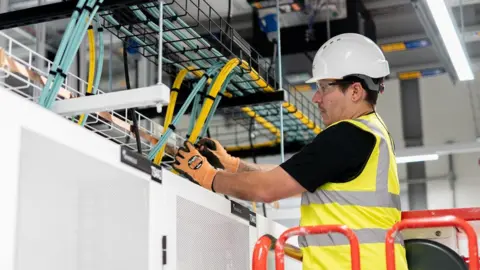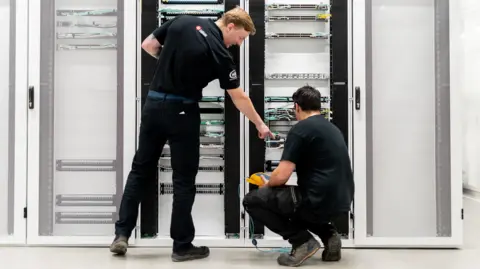
 Datalec
DatalecIf somebody had requested Billy Keeper 5 years in the past what a datacentre was, he admits: “I might not have had a clue.”
The 24-year-old joined specialist electrical agency Datalec Precision Installations as a labourer straight from faculty.
He’s now {an electrical} supervisor for the UK-based agency, and oversees groups as much as 40-strong finishing up electrical and cabling installations at datacentres.
This implies, “managing the job, from a well being and security perspective, ensuring every part goes easily, and coping with the purchasers”.
And people purchasers are central to in the present day’s know-how panorama. Datacentres are the huge warehouse-like buildings from which huge tech corporations like Amazon, Microsoft and Fb ship their cloud companies.
Different organisations, giant and small, run their very own devoted services, or depend on “co-location” datacentres to host their laptop tools.
Demand for datacentre area has been turbocharged in recent times by the rise of synthetic intelligence, which calls for ever extra high-end computer systems, and ever extra electrical energy to energy them.
Whole datacentre floorspace throughout Europe was simply over six million sq ft (575,418 sq m) in 2015, in response to actual property agency Savills, however will hit greater than 10 million sq ft this 12 months. In London alone, datacentre “take up” in 2025 will probably be nearly triple that of 2019, predicts actual property companies agency CBRE.
However whereas demand is surging, says Dame Daybreak Childs, chief government of UK-based operator, Pure Knowledge Centres Group, “delivering and satisfying that demand is difficult.”
Simply discovering sufficient land or energy for brand new datacentres is an issue. Labour’s election manifesto promised to overtake planning to encourage the constructing of infrastructure, together with datacentres and the facility networks they depend on.
However the business can be struggling to seek out the individuals to construct them.
“There’s simply not sufficient expert building employees to go round,” says Dame Daybreak.
For corporations like Datalec, it’s not only a case of recruiting workers from extra conventional building sectors.
Datacentre operators – whether or not co-location specialists or the massive tech corporations – have very particular wants. “It is vitally, very quick. It’s totally, very extremely engineered,” says Datalec’s operations director (UK & Eire), Matt Perrier-Flint.
“I’ve achieved industrial premises, I’ve labored in universities,” he explains. However the datacentre market is especially regimented, he says, with every part carried out “in a calculated and structured approach.”
 Pure Knowledge Centres Group
Pure Knowledge Centres GroupCommissioning a single piece of apparatus, resembling one of many chiller items that preserve temperatures secure inside a datacentre, will contain a number of assessments and “witnessing”, Mr Perrier-Flint explains, earlier than a last full constructing check, with failover situations.
Operators can have strict timeframes to finish a datacentre construct or improve. On the similar time, they gained’t wish to disrupt key enterprise intervals – ecommerce operators will usually put a freeze on any work within the runup to Christmas for instance.
This could imply lengthy days for Datalec’s groups, and even working shifts in a single day.
If the calls for are excessive, the rewards are vital too. Skilled electrical installers could make six determine salaries.
However, corporations like Datalec face a continuing battle to make sure they’ve sufficient suitably certified workers readily available.
 Datalec
DatalecThe Development Trade Coaching Board predicts the UK must recruit 50,300 further employees yearly for the following 5 years. Many are involved that the development workforce is greying.
Dame Daybreak says, “I believe, together with the entire different technical industries, we’re having problem feeding the pipe.”
One motive for the shortfall is a give attention to college schooling on the expense of conventional technical or apprenticeship routes in latest a long time.
Mr Perrier-Flint says that when he was youthful, the consensus was “you possibly can by no means go fallacious with a commerce, you possibly can by no means go fallacious with building”.
However there are extra decisions to tempt younger individuals now, he suggests, together with software program growth or different know-how careers. Or certainly being an influencer on the very platforms run out of the datacentres.
Mark Yeeles, vp, Safe Energy Division, UK and Eire, at energy and automation agency Schneider Electrical, started as an apprentice within the Nineties.
On condition that the business is commonly on the lookout for individuals with 15 years’ expertise, he says, “The time to begin investing in apprentices was 10 years in the past.”
Nonetheless, Schneider Electrical is altering its ratio of graduates to apprentices. “We’ve doubled our consumption of apprentices,” says Mr Yeeles.
The complete business should rethink the way it recruits youthful individuals, he provides. “My group must replicate the communities we’re working in,” he says, together with when it comes to gender, background, and expertise.
And it wants to think about the profession pathways it provides and recognise younger individuals’s want for a “mission” or “objective”. Schneider Electrical, for instance, has launched a sustainability apprenticeship program.
Dame Daybreak agrees about the necessity to improve variety and recognise recruits’ want for a mission.
“When it comes to a objective, we’re serving the entire inhabitants,” she says. “And if we might be a part of the answer for internet zero, then it is serving a big objective, as a result of it is enabling humanity to drive ahead.”
However maybe the primary problem is just explaining to potential recruits why datacentres and the cloud are central to so many aspects of recent life.
As Billy Keeper says, “You try to clarify to somebody what the cloud is and what we provide. And so they search for on the sky.”

